OPERATORS INSIDE
ROAD TRIP: The RHA’s National Lorry Week roadshow began last Monday with a launch event in Peterborough’s Cathedral Square to promote careers in road transport. Pictured (l-r) in front of a specially liveried DAF New Generation XG are RHA MD Richard Smith and key account manager Martin Dean. Local RHA member DFDS brought along drivers who have been hired as part of a driver training partnership between the RHA and Peterborough Regional College.
The four-week roadshow will see the truck travel across the UK to celebrate alongside members, industry partners, schools, colleges and government officials. National Lorry Week itself takes place from 24 to 30 October. Smith said: “Despite a drop in the driver shortage figure, the sector is still 50,000 short and the industry is still under tremendous pressure to recruit and train more of them.”

Redhead Freight to be liquidated
the DB Schenker brand in the marketplace across the UK and Europe”.
The company’s brand has been changed to DB Schenker as of 3 October.
Plans to liquidate the company and transfer its trade and assets follows a loss-making period for the company, exacerbated by the impact of Brexit and the pandemic.
pre-Covid profitability was achieved in Q4.
The report added that while the company has overcome the challenges of the pandemic it still has reservations about Brexit, warning that a lack of confidence in trade to and from Europe “creates some doubt around the speed of volume recovery and short- to mediumterm business growth”.
By Carol Millett
Redhead Freight is to cease trading this month, with the loss-making haulier’s trade and assets transferred to parent company Shenker AG, the logistics arm of Deutsche Bahn.
The Palletforce member, which trades as Redhead International, has a fleet of more than 300 trucks operating from five depots across the UK and employs 400 staff.

Headquartered in Bradford, it specialises in groupage transport services and storage and runs


scheduled services to over 40 European and North African countries.
According to Redhead Freight’s latest financial results, the company is to be liquidated. The directors’ report to the results states: “By the end of October 2022 the trade and assets of the company will be hived into a fellow group company. Following that the company will be non-trading.”

It added that the trade and asset transfer will allow the business “to benefit from the strength of
Its latest financial results for the 18 months to 30 June 2021 reveal losses of 6.6m, compared to a loss of £817,370 in the year to 31 December 2019. Turnover rose in the 18-month period to £100.2m (2019: £68m).
The directors’ report said Brexit “resulted in significant disruption to company supply chains”, requiring “significant investment in staff and additional warehouse space” and leading to a “slowing of the flow of goods in the first quarter of 2021”.
Covid-19 added further pressure with the firm seeing reduced trading volumes through Q2 and Q3 of 2020, although a return to
Sharp ■ Informed ■ Challenging 10.10.22 Berser International Cargo Services p6 Brian Yeardley Continental p8 DHL p10 ECM p3 Elddis Transport p12 Gist p14 Rhenus Logistics p10 Yodel.............................................................p4
Acquisition ambition Turners (Soham) maintains expansion strategy p3 Gefco’s sanction response Logistics firm buys back Russian-owned stake p8 Hydrogen headway Volvo to launch customer testing of FCEVs in 2025 p12 NEWS INSIDE Business barometer p16 Viewpoint p18 Fuel cards p20 Green Biofuels p26 MT Awards: Business Excellence p32; Clean Fleet Van p34 Palletforce member’s trade and assets transferred to parent company after loss-making period
ADVANCE THE PERFORMANCE OF YOUR FLEET by up to 75% find out how: 0330 124 5651 info@hireco.co.uk hireco.co.uk YOUR TOTAL TRANSPORT SOLUTION


Operator bullish about future growth strategy following strong results
Turners seeking fresh acquisitions
By Carol Millett
Turners (Soham) is continuing on its acquisition drive, despite a “dra matic” slowdown in the economy, MD Paul Day has told MT
Commenting on the company’s latest annual results, which revealed a modest rise in revenue and pre-tax profit, Day said: “We are very pleased with the results. This year started off encouragingly, but there is no question there is a dramatic slowing down in the economy and it is very difficult to predict what will happen. The budgets we set are no longer robust in the current conditions.”
Asked if the firm’s acquisition strategy would be impacted, Day said: “We are a long-term player in the market and we are always looking for opportunities,” adding that he is pleased with the perfor mance of the company’s latest acquisitions.
The Newmarket-based company, which employs 3,975 staff and operates a fleet of 2,252 trucks, acquired MKT Logistics and its three subsidiary companies Matthew Kibble Transport, Shakespeare Transport and Fullforce Logistics in July this year and bought a 50% stake in A Hardwick Haulage in June 2021.

According to its results for the year to 1 January 2022, turnover at Turners (Soham) rose by 8% to £505.5m (2020: £465.4m) with pre-tax profit increasing by 2.3% to £61.2m (2020: £59.8m).
All but one of the company’s four divisions saw revenue rise in the year, with only the general haul age division seeing turnover dip.
Palletline prepares for £6m investment programme
Palletline will roll out one of the most ambitious investment programmes in its history next year when it spends £6m on properties, new technologies and also its network.
It said it had enjoyed “unprecedented success” over the last year, including a 19.4% increase in revenues, and it now wanted to ensure its future sustainability in order to handle the economic headwinds predicted by analysts.
Palletline said it would expand its Coventry and Birmingham sites as well as begin a five-year contract with Linde, which will see a new fleet of forklifts being introduced across the business, some of which will be electric.
Palletline also intends to develop a new IT platform and deliver a seven-figure project implementing CCTV technology on its forklifts, to increase visibility and accountability.
Warning over plans to repeal IR35 changes
Operators planning to hire self-employed drivers following Chancellor Kwasi Kwarteng’s promise to repeal changes to the IR35 offpayroll working rules could still fall foul of the Transport Commissioner and HMRC.
The warning comes from Kieran Smith, chief executive of driver agency Driver Require. It follows changes announced in Kwarteng’s controversial mini-budget, which will once again allow self-employed drivers, operating as personal service companies (PSC) or as limited companies, to manage their tax and NIC affairs and determine whether they are genuinely self-employed, transferring that responsibility away from the haulier or end client.
The government aims to introduce the changes by 6 April 2023. However Smith warned hauliers against rushing to reinstate the use of self-employed drivers since the changes could be delayed by the Parliamentary process.
“This opens it up to substantial risk of challenge, rejection and/or demand for replacement measures and legislation,” said Smith. Operators with drivers who are planning to switch to a self-employed status, without any major changes to the way they work, should also beware, he warned.
ECM losses deepened ahead of buyout
Vehicle transportation specialist ECM (Vehicle Delivery Service) saw losses increase in 2021 as the dual impact of the Covid-19 pan demic and the semiconductor shortage took its toll.

In its latest annual results to 31 December 2021, the company reported pre-tax losses of £553,895 (2020: -£391,578), despite turnover rising to £78.1m (2020: £74m) in the year.
These are the first annual results published by the company
since its purchase by Constellation Automotive group in August for an undisclosed sum. The group also owns ECM rival BCA, includ ing BCA Automotive Logistics, BCA Automotive Services and WeBuyAnyCar.com.
In its annual review of the busi ness, ECM said that Covid-19 had dealt a “major impact” in 2021 as well as the semiconductor short age in the automotive industry.
On the upside, the review noted that at year end the company had
cash at the bank of £6.7m, adding that it has held strong cash balances during the year, resulting in “minimal” cashflow risk.
The directors are now looking to secure new contracts and invest in fleet, employees and IT systems. n The integration of Clipper Logistics into GXO has begun, following unconditional regulatory clearance from the UK Competition and Markets A uthority (CMA) for the acquisition.
MotorTransport 310.10.22 motortransport.co.uk News
Yodel builds on record growth

Parcel carrier Yodel is opening a new 161,900sq ft depot in Huyton, near Liverpool, after seeing record growth last year.
Announcing the move, Yodel said this latest investment is part of plans to continue expanding nationwide operations, with the business expecting to handle over 200 million parcels in 2022.
As well as looking to build on its parcel capacity, Yodel is also targeting growth in the delicate and irregular shaped parcels sector by installing the Merlin dedicated sortation system at its centres in
Wednesbury and Shaw.
The Huyton depot, at Tritax Symmetry Park in Merseyside, is set to open ahead of summer 2023.

The facility is being built by GMI Construction Group to a Net Zero Carbon standard and is on target to achieve a BREEAM Excellent rating.

Mike Hancox, Yodel chief executive officer, said: “This is a very exciting period for Yodel and the new depot in Huyton is an important step in expanding the business, ensuring that we can be more dynamic and fit for purpose.”
Winch & Co lays out ambitions for logistics group
Private equity firm Winch & Co is in talks to buy a third haulage firm as part of plans to build a group of five logistics and haulage companies within the next six to 12 months, the Leeds-based investor has revealed.

It is also pumping £550,000 into Loughborough-based Eclipse Distribution, which it bought in October 2021. The company said the investment will help bolster the haulier’s position and clear

down legacy credit balances left by the outgoing management.
The equity firm has also injected £250,000 into Cramlington-based Dedicated Transport Solutions, which it bought in April this year, along with the firm’s 250,000sq ft industrial estate.
The £550,000 investment into Eclipse Distribution follows a bumpy ride since its acquisition last year. The management teams of both Winch & Co and Eclipse Distribution said the transition “hasn’t been as smooth as other acquisitions”, with the company experiencing a “tumultuous time” which has seen the driver shortage crisis, fuel price hikes and the costof-living crisis, brought on by disrupted supply chains because of the war in Ukraine.
TruTac and Microlise software products have together improved numerous aspects of our compliance control and fleet efficiency. Quite honestly, I


think
which
other
motortransport.co.ukNews 4 MotorTransport 10.10.22
We are talking Compliance Control & Fleet Efficiency!
can’t
of
systems
could compete! Jon Mayes. Managing Director, AD Fuels. Complete Compliance Control THE QUEEN’S AWARDS FOR ENTERPRISE: INNOVATION 2020 024 7669 0000 | info@trutac.co.uk www.trutac.co.uk TruTac is ER-accredited +44 (0)1773 537000 www.microlise.com Part of the Microlise Group











New owners promise to invest in team and build on Palletways member’s reputation for reliability
Industry duo swoop for Berser
By Tim Wallace Transport industry veterans
Richard Harris and Mark Bigley (pictured l-r) have acquired Staffordshire-based logistics firm Berser International Cargo Services, which is a member of Palletways and part of Imperial Logistics.
The pair said Berser’s historically strong performance within the Palletways network, recent



fleet investment and top-performing operations and driver team were key factors in the move.

With headquarters in Newcastleunder-Lyme, the firm employs 29 staff, of which 22 are drivers, and covers the ST and CW postcodes.

Berser’s Leeds-based business, which focuses on e-commerce fulfilment logistics, is supporting the change.

In a statement, the joint direc-

tors said: “Berser is a steadfast company whose relationships with customers are built upon reliabil-
GOD’S PLAN: Freight management start-up Zeus has expanded into Europe after signing up with fashion retailer Primark. The partnership will see Zeus handling freight transport for the retailer on routes to France, Italy and the Czech Republic. It comes as Zeus recently marked its second anniversary. Under the agreement, Zeus is starting with distribution to destination stores in Italy and fixed ad hoc work to Czechia and France.
ity and communication and we don’t plan on changing what works. Our team are the key to this and are what make the business what it is.
“We recognise our responsibility to ensure we grow the business mindfully, working with sustainable and environmentally aware suppliers and customers. This has already extended to training and development for team members, the introduction of IT systems to streamline our processes, thousands of pounds of investment in our premises, and the appointment of a new commercial manager.
“We’re committed to growth in terms of pallet collections, local deliveries and haulage across the UK. We’ll continue to invest in our people and technology to provide even greater customer service, and to adapt to changing consumer buying patterns, whilst ensuring we remain competitive.”
motortransport.co.ukNews 6 MotorTransport 10.10.22
source > finance > maintain > TRAILER > TRUCK > VAN > source > finance > maintain > TRAILER > TRUCK > VAN > source Hireco can alleviate your fleets downtime by up to 75%. We provide total visibilty in real time and retrospectively. Giving you the opportunity to react to small issues before they turn into big problems. How? Smart asset technology including EBPMS, TPMS and DTC monitoring as standard. Hireco takes away your transport concerns, allowing you to focus on what you do best. LET HIRECO ADVANCE THE PERFORMANCE OF YOUR ASSETS YOUR TOTAL TRANSPORT SOLUTION 0330 124 5651 > info@hireco.co.uk > hireco.co.uk












Gefco gets back on track after cutting Russian ties
International logistics firm Gefco has described how its global business became “exceedingly difficult” following the invasion of Ukraine by Russia, due to its association and links with state-owned rail firm Russian Railways.
The haulage and shipping giant said its ultimate parent undertaking was placed under sanction controls on 24 March by the US, EU and UK authorities after the illegal invasion.
Gefco UK said the authorities agreed that these sanctions should not impact upon its business, because it is an independently run company registered in France and


so the UK government’s Treasury issued it with a “licence for Continuation of Business”.
But in its accounts for the year ending 31 December 2021, the company said: “Despite this clarification, conducting our daily business with our worldwide customers and business partners became exceedingly difficult due to our shareholding structure.
“As a result of these difficulties, Gefco’s management board and Gefco’s supervisory board decided to buy back Russian Railways’ 75% stake in the group. The buyback was completed on 6 April 2022.”
Its immediate parent company, Gefco SA, then sold these shares to Ceva Logistics parent company CMA CGM Group and it went on to acquire the remaining 25% on 8 April.
The Continuation of Business licence was revoked on 12 April as Gefco was no longer deemed sanctioned by association.
Brian Yeardley strikes right note
The wheels kept on rolling for Brian Yeardley Continental in 2021, aided by a return to the stage for bands and artists keen to get back on the road and perform.
The company increased turnover by 3.4% to £10.9m in the year ending 31 December 2021.
Pre-tax profit increased by 17.6% during the period to £809,000.
Brian Yeardley Continental is split into two divisions; a UK and European general haulage and groupage logistics side and a UK

and European live events division.

The events division reported revenues of £1.3m in 2021. This was down on 2020’s £1.4m, but the company pointed out that £1m of that was attributable to preCovid activities.
The haulier entered into a company voluntary arrangement (CVA) in 2020 after turnover plummeted by 60% during the pandemic and it provides that creditors receive a minimum payment of 28p in the pound.

motortransport.co.ukNews 8 MotorTransport 10.10.22
Photo: Shutterstock THE FUTURE IS NOW. EFFICIENT. INNOVATIVE. SUSTAINABLE. Follow us prometeon.com Brave, visionary and always driven by constant search of technological innovation, Prometeon reveals a new breakthrough. Serie 02 – a brand new family of cutting-edge tyres, designed to perfectly balance durability and sustainability, efficiency and performance. Let yourself be part of the future. Copyright © 2022 Prometeon Tyre Group S.r.l. The PIRELLI logo is trademark used by Prometeon Tyre Group S.r.l. under license.

















Service aims to streamline international deliveries by allowing customers to consolidate orders
Palletways launches Hubdrop
By Carol Millett
Palletways has launched a direct injection ‘Hubdrop’ service aimed at reducing transit miles and deliv ery times.

The launch follows a successful pilot carried out earlier this year by the network, with the service now being rolled out across the UK and Palletways’ networks in the Benelux, Iberia, Italy, Germany and Hungary.
International deliveries can currently take around seven days but Hubdrop enables customers that regularly ship large volumes of consignments every year inter nationally to consolidate orders onto one of their trucks, or that of their nearest member, and directly
Rhenus Logistics on the up, but profit falls
Strong demand for UK warehousing and storage services since Brexit helped Rhenus Logistics boost turnover by 8.2% last year.
However, profit fell due to increased employee costs, reduced assistance from the government’s furlough scheme and inflationary pressures.
Latest financial results for the year ending 31 December 2021 showed revenue rose to £12.4m from £11.4m in 2020.
“The increased turnover has been primarily driven by strong demand for UK warehousing and storage services following the Brexit customs formalities changes and related uncertainties,” the company said.
inject the consignment at one of Palletways’ 15 participating hubs within any of the core countries it serves. The member network then handles the final leg of the journey.
Benefits include fewer transit miles and reduced delivery times with consignments arriving at their destination the day after the drop-off at the hub.
Hubdrop is also backed by Palletways’ IT infrastructure, with each consignment fully traceable from the time it’s collected at the hub until the point of delivery. n Palletways Bristol has been cho sen as spice manufacturer Bart Ingredients’ freight partner of choice following a competitive tender.
DHL breaks ground at Coventry hub

DHL has announced the start of construction on its £230m hub in SEGRO Park Coventry.
The facility will double DHL’s handling capacity and is expected to create 650 new jobs for the area.
This latest project is part of DHL’s £482m investment strategy to drive growth in the UK, which has seen it launch 10 new collection and delivery depots across the UK and expand 20 more existing sites.
Construction of the new 25,000sq m hub, located south of Coventry Airport within Warwick District, is expected to be completed in summer 2024. It will have the capacity to handle well over 500,000 items per day and will feature secure bonded storage and customs capabilities to support international e-commerce.
FORS attention on offside blind spots
New requirements for achieving accreditation in the Fleet Operator Recognition scheme (FORS), which puts renewed focus on eliminating blind spots, have been welcomed by Brigade Electronics.
Effective from July, the scheme now recommends that operators monitor front and offside blind spots after police research showed 32% of accidents resulted from right-hand-side swipes.
Right-hand-drive vehicles are also now required to have an audi ble alert when turning right, while rigids over 7.5 tonnes are now required to have a camera system that monitors the rear blind spot.
FORS is also asking operators at Silver level to fit cameras that are able to digitally record inci dents and assist in driver training and development.
‘Business as usual’ pledge as DVSA brings JAUPT in-house
The DVSA said it was business as usual for processing applications from training provid ers for DCPC courses after it brought the Joint Approvals Unit for Periodic Training (JAUPT) in-house.
Originally set up on behalf of the DVSA’s predecessor, the DSA, to administer the appli cation process for the DCPC, JAUPT is now being brought within the enforcement agency’s remit because it was offering this service exclu
sively to the DVSA. Bob Hannigan, DVSA head of national standards and accreditation, said: “As well as providing continuity of service for training and rehabilitation providers and profes sional drivers, this change will benefit my team and the wider agency through the knowledge and skills that the JAUPT team bring with them.
“We are keeping the transition as smooth as possible for colleagues and customers and will keep people updated with any changes as the
work progresses to embed the new service into our organisation.”
The DVSA said there had been no redundan cies as part of the move, which took effect from 1 October, and JAUPT staff will work in a new office in Milton Keynes – where they were already based. It added that all JAUPT contact details remained the same and the way courses and centres are approved and audited will not change.
motortransport.co.ukNews 10 MotorTransport 10.10.22












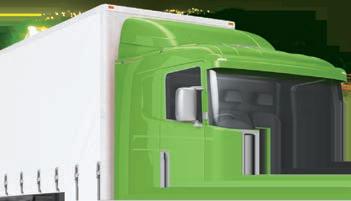

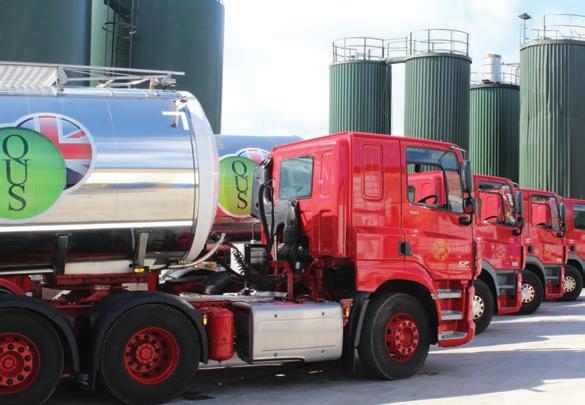




















Selected European customers expected to test latest fuel cell vehicles
Volvo eyeing 2025 for hydrogen truck trials
By Carol Millett
Volvo Trucks is planning to roll out customer testing of its hydro gen fuel cell electric trucks in 2025.
The trucks, which only emit water vapour, are currently under going intensive testing and have



an operational range comparable to diesel trucks of [up] to 1,000km.
The pilot phase will see selected customers in northern Europe test the vehicles on public roads, using green hydrogen from renewable sources, which will be provided at operators’ depots.
The trucks are targeted at the long-distance and heavy-duty truck markets and at countries with limited battery charging possi bilities. They will use two fuel cells with a capacity to generate 300kW of power and will have a refuel time of less than 15 minutes.
Jessica Sandström, Volvo Trucks SVP of global product manage ment (pictured), said: “The tests will run in a demanding, harsh climate and also give us a great


opportunity for driving with heavy loads up to 65 tonnes.”
The technology is still in an early phase of development with “some challenges” remaining – not least the large-scale supply of green hydrogen and the need to develop fuelling infrastructure.

To overcome the lack of avail able hydrogen during the pilots, green hydrogen from renewable sources will be provided at the home depot.
“We expect the supply of green hydrogen to increase significantly during the next couple of years, since many industries will depend on it to reduce CO2. The fuel cell trucks will be important for longer and heavier transportations in a few years from now,” Sandström said.
Freeway boosts Elddis visability
Elddis Transport is rolling out new mobile working technology as part of a programme to digitise the workshop.

Workshop fitters are being equipped with rugged tablets to replace paperwork, as part of a fleet maintenance system from Freeway Fleet Systems.
Freeway also receives drivers’ daily vehicle inspection data from mobile, which along with the workshop digital data gives Elddis a complete and real-time insight into the status of the fleet.
The Consett-based family firm specialises in the storage, supply and delivery of consumer goods for supermarkets and retail outlets.
Transport operations are given around-the-clock visibility of the status of the fleet through integra tion between Freeway and the Mandata transport management system (TMS). In turn, the work shop is provided with immediate information on defects using data received from mobile terminals used by drivers.

motortransport.co.ukNews 12 MotorTransport 10.10.22
Reduce your carbon footprint and minimise fuel costs by following FORS policies and procedures FORS Gold and Silver Operators report a 3% improvement in their fuel economy Scan for a free fuel management guide Follow us on@FORS_onlinefors-online.org.uk 08448 09 09 44 SAFER SMARTER GREENER FLEET OPERATOR RECOGNITION SCHEME Fuel Management Mastered


Around
HGV drivers count cost of new Bradford CAZ
 By Chris Tindall
By Chris Tindall
Drivers of non-compliant HGVs entering Bradford will now be forced to pay £50 a day after the city launched its own clean air zone (CAZ).

Bradford has been identified as exceeding air pollution levels at several locations and the metro politan city council said many of
these were in inner-city areas.
It said its CAZ has been designed around areas where the levels exceed legal limits and it expects an average of 140,000 vehi cles each day will drive through the zone.
Chargeable, non-compliant vehicles will make up around 4% of all traffic, due to local businesses
having already upgraded their fleets. Susan Hinchcliffe, leader of the council said: “Bradford is acting on a government directive to implement a charging Clean Air Zone.
“After protracted negotiations with the government, the CAZ has been designed very carefully to exempt private cars, motorbikes, and local businesses, while having an immediate and material impact on the air we all breathe.” n NOx emissions from HGVs have fallen by at least 72% in the UK since 2013, according to a new report from the RHA. Its 2022 NOx Emission Assessment said the improvement had been largely driven by hauliers, who have invested £2.2bn in Euro-6 trucks since 2014.
Gist stable ahead of
buyout
As Marks and Spencer Group’s acquisition of Gist nears comple tion, the logistics firm revealed a modest rise in pre-tax profit for last year.
Reporting its annual results for the 53-week period ending on 1 January 2022, the company unveiled a 17% rise in turnover to £551.5m (2020: £471.8m) with pretax profit rising 3.3% to £34.1m (2020: £33m).
Marks and Spencer Group announced its purchase of Gist in July last year, with the deal valued at around £255m. Gist employs more than 5,600 staff and operates a fleet of over 1,800 trucks and 2,300 trailers. It is the principal contract logistics provider to M&S Food and is currently owned by Linde Group subsidiary Storeshield.
The firm provides the bulk of M&S Food logistics services via eight primary and 10 secondary distribution centres across the UK and the Republic of Ireland, including a number of freehold warehouses.
motortransport.co.ukNews 14 MotorTransport 10.10.22
5,600 vehicles each day expected to be hit with £50 charge
M&S
Photo:
Shutterstock Confidential 24x7 helpline available to the industry’s workforce and their families 0345 605 1956 www.constructionindustryhelpline.com www.constructionindustryhelpline.com







Earning more, buying less
Haulage rates
Typical haulage rates in the second quarter of this year (Q2) were 3.7% up on Q1, and 11.4% higher than in Q2 last year.
Both these quarterly and annual increases are the largest on record, according to the Office for National Statistics (ONS), which collates haulage rate data for its Services Producer Price Index (SPPI).
The ONS records go back over 25 years, to 1996. For comparison, the average quarterly rate increase during that period is 0.6% and the average annual increase is 2.3%, so Q2’s figures are five or six times larger.
Costs relating to transport and storage are currently the fastest rising of all the services provided to UK businesses, according to the ONS data. These show that haulage rates have risen by 50% since the end of 2004.
Earnings
Business Barometer has avoided the subject of earnings for the past couple of years because Covid fur lough payments undermined yearon-year comparisons. But the Covid effect is now diminishing and surging inflation puts earn ings centre stage.
The latest ONS data indicate that average total weekly earnings in the three months to the end of July were 5.5% higher than in the same period a year ago. This latest headline figure of 5.5% needs two important qualifiers.
First, it is an average that encom passes two widely different scenar ios: earnings in the public sector were only 2.0% up, but they rose by 6.2% in the private sector.
Second, the 5.5% rise in average weekly earnings is nominal growth. Adjusting for inflation, average weekly earnings in real terms during the three months to the end of July were 2.6% lower than a year ago.
But even that needs further expla nation. That figure has been calcu lated by applying CPIH (consumer price index, including owner occu piers’ housing costs) to adjust for inflation, but if the usual CPI infla tion measure is used, the reduction in earnings is 3.6%.
Whichever way you slice the data, earnings growth is only on paper: the reality is that we have less buying power.
The accommodation and food sector recorded the fastest earn ings growth in the three months to July, posting a figure of 7.6%.
However, the ONS points out that this sector had the highest proportion of employees still on furlough payments a year ago, so that affects even this latest figure. The furlough scheme ended on 30 September 2021.
Sterling
The pound’s loss of value against other major currencies is contrib uting to inflation by pushing up the cost of imported goods, espe cially fuel.
Our chart, depicting sterling’s monthly average values against the dollar and the euro, just misses further declines in the past few weeks.
As this is written, the pound’s September averages stand at just $1.15 and €1.15, representing losses since February of 15% and 4% against the dollar and the euro respectively.
Although the pound’s value against the dollar is the lowest since 1985, this figure largely reflects the strength of the dollar. The US Federal Reserve is raising its bank interest rate aggressively: it is now up to 3.25%, tempting investors to the dollar for better returns.
The dollar is also widely regarded as a safe haven for funds when the global situation is uncer tain. And crucially, the US is less exposed than Europe to Russia’s gas stranglehold. Europe’s battle against overwhelming energy costs explains why the euro is also strug gling against the dollar.
Nevertheless, the fact that ster ling stands at a 17-month low against the euro is a sobering thought. By the time you read this we will know if the UK’s bank rate hike to a 14-year high of 2.25% on 22 September has arrested the pound’s decline.
Retail sales
The latest retail sales data from the ONS succinctly illustrate the real-world meaning of inflation. The value of retail sales in the three months to the end of August was 5.6% higher than in the same period a year ago, yet the volume of goods purchased was 5.1% lower.
HAULAGE
EARNINGS
EXCHANGE
such as furniture. Consumers are clearly deferring these lowerpriority purchases.
If this pattern persists it may test the resilience of some busi nesses, including their logistics operations. Basic economics says even a profitable business can be brought to its knees by temporary cash-flow problems.
motortransport.co.ukBusiness barometer 16 MotorTransport 10.10.22
Rates and earnings are up but high inflation and a falling pound mean the gains are only on paper
This ‘spend more but buy less’ trend started in spring last year and the divergence between the two metrics has grown ever since. The decline in the volume of goods bought is seen across all retail sectors, but most notably in the non-food category and in particular in household goods
GROWTH
RATES
RATES 0.0 0.5 1.0 1.5 2.0 2.5 3.0 3.5 4.0 Q3´20Q4´20Q1´21Q2´21Q3´21Q4´21Q1´22Q2´22 % increase on previous quarter 0.0 1.0 2.0 3.0 4.0 5.0 6.0 7.0 8.0 JanFebMarAprMayJunJul Average annual growth (%) three months to... 0.80 0.90 1.00 1.10 1.20 1.30 1.40 FebMarAprMayJunJulAug £1 buys.... $ €

Will rates match running costs?

The newspaper for transport operators
To contact us:
Tel: 020 8912 +4 digits
Steve Hobson Editor Motor Transport
The turmoil in the currency markets that led to our new chancellor Kwasi Kwarteng reversing his controversial plans for tax cuts for the top earners may have seemed to be happening remotely on a planet far, far away, but the weakness of sterling against the US dollar really does matter. Just about every commodity that goes into building and running trucks from oil to steel is traded in dollars, so if the pound sinks against the dollar, inflation will be given yet another upward twist.
Young people born since the 1980s won’t remember the days of double-digit inflation and interest rates. It will be a severe shock to the system for this highly indebted generation, which has bought property and leased new cars on the basis of very low interest rates. The Bank of England no longer thinks we are already in recession but it looks nailed on that we will be in one by Christmas.
Many companies rely on a pre-Christmas boom in consumer spending to make any
money for the whole year. While peaks cause headaches for the logistics sector, this spike in demand is built into operators’ budgets and if it goes AWOL it will leave a big hole in revenue. The driver shortage and the ludicrous signing-on bonuses of last Christmas should however disappear, much to the relief of hauliers struggling to hang on to staff.
While running costs are rising and volumes look very uncertain the good news is that customers are accepting that rates have to increase if service levels are to be maintained. Our regular business barometer (page 16) shows that rates rose 11.4% between Q2 2021 and Q2 this year – the highest increase ever recorded.
The $64,000 question is whether rates will continue to match running costs if the UK economy hits the buffers. The government has pledged to get Britain growing again but the jury remains out on how soon that promise will be delivered.
Why subsidise fuel cell technology?
or email: name.surname@roadtransport.com
Editor Steve Hobson 2161
Head of content Tim Wallace 2158
Events and projects editor Hayley Tayler 2165
Group production manager Isabel Burton
Senior display sales executive
Barnaby Goodman-Smith 2128
Event sales Tim George 0755 7677758
Classified and recruitment advertising
rtmclassified@roadtransport.com
Sales director Emma Rowland 07780 604075
Divisional director Vic Bunby 2121
MT Awards Katy Moyle 2152
Managing director Andy Salter 2171

Editorial office Road Transport Media, First Floor, Chancery House, St Nicholas Way, Sutton, Surrey SM1 1JB 020 8912 2170
Free copies MT is available free to specified licensed operators under the publisher’s terms of control. For details, email mtsccqueries@roadtransport.com, or call 01772 426705
Subscriptions
RoadTransport@abacusemedia.zendesk.com 020 8955 7034


Motor Transport Subscriptions, Abacus, 107-111 Fleet Street, London EC4A 2AB
David Cebon Founding member, Hydrogen Science Coalition

When Celia Greaves, CEO of the UK Hydrogen and Fuel Cell Association requests “a clear roadmap with appropriate policy levers to guarantee scale up and growth” (MT 26 September), she means that she wants the government to define its subsidy regime for use of hydrogen in transport. But why do fuel cell vehicles need subsidising? The industry’s argument is that it needs to scale production so as to reduce costs, but hydrogen will never be able to compete on costs with direct electrification of vehicles.
The fundamental problem with hydrogen-powered transport is energy waste and consequently excessive cost. Powering fuel cell electric vehicles (FCEVs) with green hydrogen uses three times more electricity than powering battery electric vehicles (BEVs) for the same task. FCEVs are also considerably more expensive than BEVS and are likely to remain that way.
Car and light van manufacturers have recognised this fundamental cost problem. They have pivoted away from hydrogen and embraced battery electric solutions. The direct consequence is that there are approximately 20,000,000 battery electric cars in the world but only 20,000 FCEVs.
Hydrogen has comprehensively lost the battle for the car and light van market because it is too expensive. Should the government actively prop-up this industry?
The same factor of three on operating cost carries over to the truck market, where hydrogen is being promoted for heavy haulage. However, the logistics industry is
far more sensitive to price than the car market, so FCEVs will be an even harder sell to cash-strapped haulage companies.
Consequently, in this case the relevant question is not whether hydrogen should be subsidised, but whether existing road haulage operations can be performed by battery electric trucks with appropriate charging infrastructure. Because if BEVs can do the job, there is no way that hauliers will purchase FCEVs at scale.
The Centre for Sustainable Road Freight has simulated tens of thousands of current logistics journeys around the UK to establish whether they could be performed (with minimal time penalty) by BEVs with chargers located at truck stops, warehouses and depots. No case has been found where a BEV with a reasonable battery size couldn’t do the job. Furthermore, financial predictions are that efficiency gains from electrification should be sufficient to pay the additional costs of charging infrastructure and consequently that government subsidies should not be necessary for battery electric trucking.
The transport industry needs to move forward on a self-sustaining, financially viable footing. It will naturally choose low-cost electric solutions. Fortunately, unlike hydrogen-based solutions, BEVs will not need to be propped up by subsidies that are subject to the whims of successive governments.
Got something to say?
Rates UK £146/year. Cheques made payable to Motor Transport. Apply online at mtssubs.com
Registered at the Post Office as a newspaper
Published by DVV Media International Ltd


© 2022 DVV Media International Ltd
ISSN 0027-206 X
motortransport.co.ukViewpoint 18 MotorTransport 10.10.22
If you would like to contribute to MT’s Viewpoint, email steve.hobson@roadtransport.com
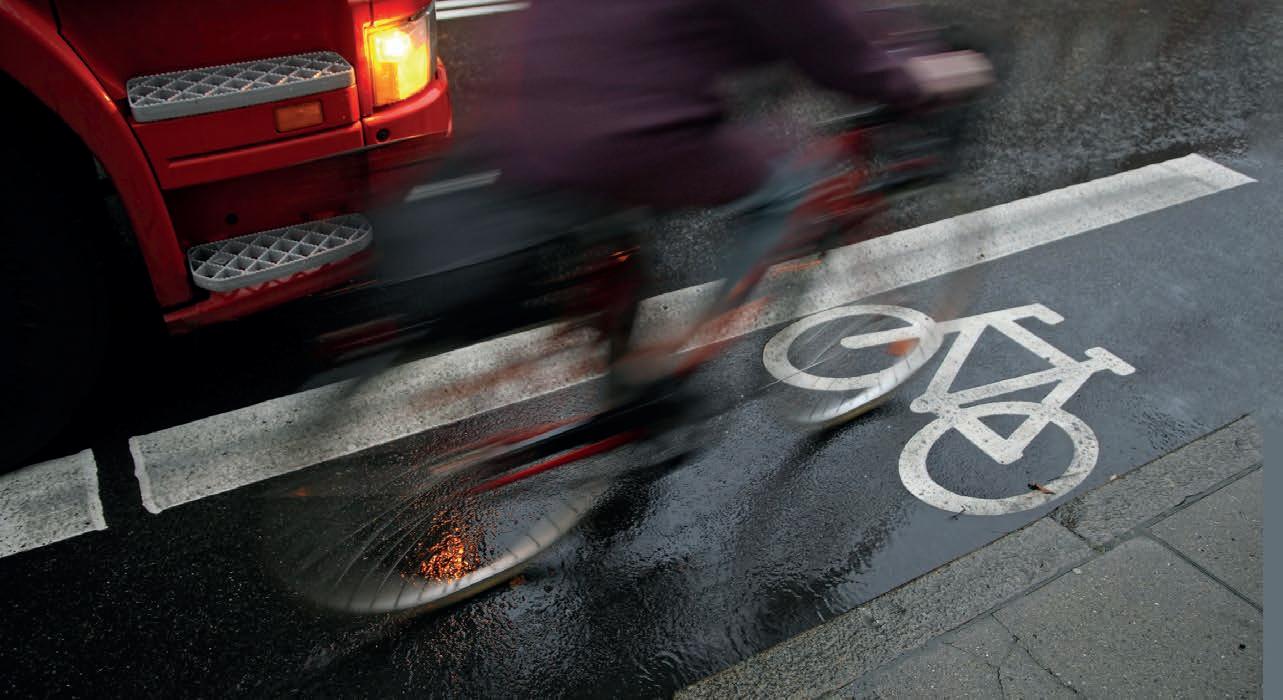


Paying for fuel with a plastic card is a rmly established practice, with a selection of cards dedicated to speci c fuel brands, either supplied directly by the fuel company or by card brokers who can supply branded fuel cards speci c to customer needs. In some cases, radio frequency identi cation (RFID) tagged keys will perform the same function, perhaps for unattended fuel or natural gas fuel sites, where driver, vehicle and operator can all be identi ed and fuel charges made accordingly.
Nothing is forever and the chances that we will still be paying for fuel with a plastic card in 10 years’ time look as though they are being challenged by digitisation. The emergence of smartphone payment systems such as Apple Pay and Google Pay has led the way for other app-based payment methods. It seems likely that truck drivers won’t have to worry about cluttering their own smartphones up with apps to pay for fuel or charging either. Connected vehicles will be able to deal with transactions direct from the cab and there will be no need to go into the fuel station to pay.
Let’s get digital

The IAA Transportation show in Hanover last month gave MAN the opportunity to claim that it is the first truck manufacturer “to develop a digital platform for all payment processes relating to commercial vehicles”, when it launched MAN SimplePay at the show. MAN says this is “a first step towards a complete payment ecosystem for different services”.











The company has formed a partnership with BP to launch an automated, contactless, secure payment system for refuelling without cards or cash, with all payments made direct from the cab. The driver will not need to walk to the forecourt shop to pay. Even so, it’s hard to imagine that drivers will forego coffee and snacks, so maybe the walk to the shop is not over yet. MAN also suggests that reduced human contact is a benefit in pandemic times, but it could equally be one less point of human contact for drivers who spend most of their working life alone.
The MAN SimplePay payment is processed from the cab via the RIO telematics box fitted to the vehicle. RIO is the Traton Group’s digital division. The payment will be digitally processed by payment processor Stripe. The cloud infrastructure that handles and stores the data is provided by Amazon Web Services.
MAN customers wishing to sign up to MAN SimplePay will be able to do so via the online MAN Marketplace. The service will then be installed on the vehicles concerned, over the air, without the need for the vehicles to visit a workshop.
Customers won’t have to wait long to sign up and the first country to get the system will be the UK. After Hanover closed, the system became available to pilot customers here, followed by Germany, before being rolled out to other countries. Just like some fuel cards, MAN SimplePay will be expanded to things such as payment guarantees in the event of a breakdown.
The partnership with BP will also provide that company with its own branded app version of the system, bp InTruck Connect. This will fit with BP’s plans to develop dedicated electric charging and hydrogen sites for HGVs. The company hopes to build a network of ‘mobility hubs’ along key truck routes across Europe, which will include a range of HGV fuels including diesel, HVO, electricity, hydrogen and natural gas biofuels. Initially bp InTruck Connect will be dedicated to MAN vehicles, but
Are YOU playing your cards right?
The traditional method of paying for fuel on a plastic card looks set to be a thing of the past before long as commercial vehicles embrace new digital platforms. John Kendall reports


motortransport.co.ukFuel cards 20 MotorTransport 10.10.22
➜ 22 Photo: Shutterstock
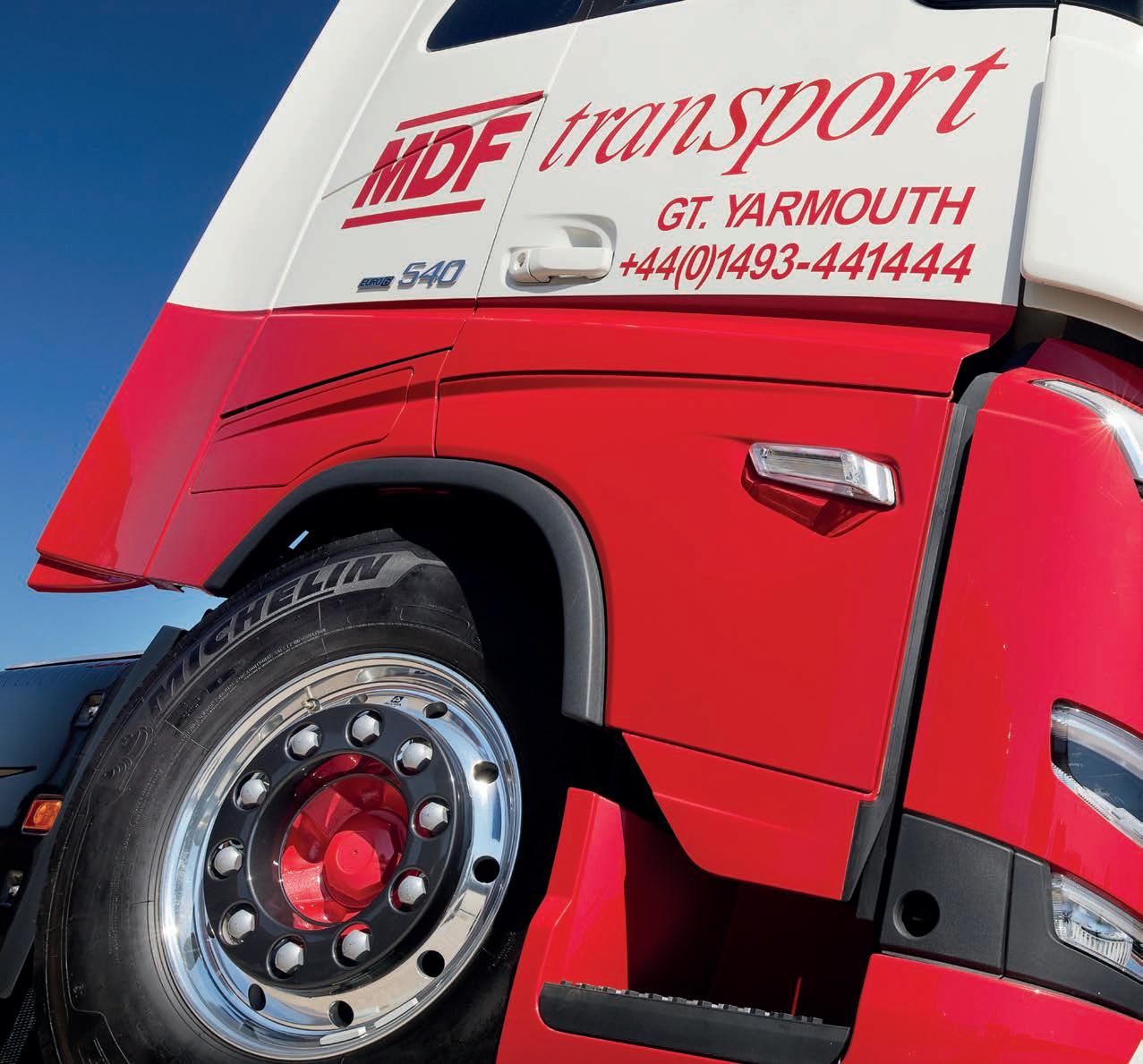
AN INSIDE JOB: Using the MAN SimplePay system, drivers will be able to pay for fuel wthout leaving the comfort of their cabs
we may not have to wait long for an announcement from Daimler.
According to Alexandru Eftimiu, vice-president of bp fleet Europe: “We aim to use digital technology to enhance the customer experience and provide the very best service to fleet managers, while simplifying the refuelling process for truck drivers. With our InTruck Connect solution, drivers can refuel and be back on the road in three simple steps.
“Drivers just need to confirm the fuelling site on their MAN truck infotainment system, unlock the pump and refuel. The truck logs the transaction and pays for the fuel itself. InTruck Connect makes the process efficient and easy, so that drivers and managers can save time and have more security and transparency over their fuel purchases.”
Added security
Drivers will not need to record mileage, because that information will be automatically downloaded with the transaction. The system is also designed to help guard against unauthorised transactions.

BP Fleet introduced its fuel and charge card over two years ago to provide a single charge card for fleets with conventionally fuelled and electrically powered vehicles, enabling payment for either hydrocarbon fuels or elec tric charging on the BP Pulse network from the same card. BP Pulse can provide charging facilities at depots as well as on the road.
BP now holds stakes in both biogas supplier Gasrec
and HVO supplier Green Biofuels. The company is also part of a consortium to build a hydrogen hub at Teeside, which will produce both green (from renewable sources) and blue hydrogen. “We will envisage to enable fleets to use fuel cards for the complete energy mix – HVO and gas, as well as hydrocarbon”, says Adrian Brabazon, head of UK fleet solutions at BP.
It seems highly likely that the system developers also have an eye on the arrival of autonomous vehicles at some stage in the future. Since refuelling or charging could then be taking place without a driver present, a system that is already set up to handle payments direct from the vehicle would be fairly easily adapted to deal with a driverless vehicle.
Gridserve is a relatively new player in the vehicle charg ing network, rolling out a series of EV charging hubs across the country – and with plans for more. The company also acquired the Ecotricity Electric Highway motorway charging network last year and has been involved in improving this underdeveloped network since.
Charging network
New meets old in the company’s recent partnership with long established fuel card supplier Allstar. This means that users of the Allstar One Electric card can pay for charging at the Gridserve Electric Highway motorway charge points. Allstar claims the card is the first thirdparty payment method to be accepted on the Gridserve electric network. The news will probably benefit ➜ 24
motortransport.co.ukFuel cards 22 MotorTransport 10.10.22

















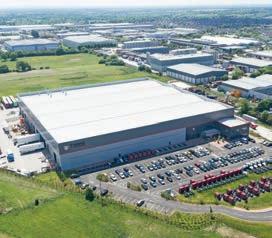







NO RUSH TO ELECTRIC CHARGING
At the moment, FleetMaxx marketing manager Steve Clarke is not noticing a trend towards EVs among his customers. “It’s still too early to say. We’re getting a lot of general enquiries and businesses gathering information about the availability of charge points on our MaxxEV Chargepass network, but firm decisions don’t appear to be being made yet,” he told MT.
The company offers fuel cards that integrate traditional fuels and EV charging on one card, which can then be billed on one invoice. “That’s starting to prove a popular option with mixed fuel fleets, as it keeps the admin to a minimum, and the ability to only deal with one supplier,” says Clarke. “With respect to alternative fuels such as hydrogen, none of our partners are currently able to offer that facility, but have it on their ‘to do’ lists.”
How much could high diesel prices in recent months encourage some fleets to give more consideration to electric vehicles? “It has certainly caused buyers to seriously investigate EV and the improved availability and charging options, as well as the total costs of ownership,” reckons Clarke. “However, with the uncertainty of electricity prices over the last few months, this has caused some concern to our customers.”
With reports that some charging providers have raised rapid charging costs to £1/kWh, this doesn’t come as much of a surprise.
As the move to EVs gathers momentum, charging options for trucks could include depot charging at other hauliers’ premises, as well as charging back at base and on the road. “Smart charging points are able to cater for this quite easily and can even be used as a means of generating income from public use,” says Clarke. ”Our panel of charging point providers will undertake a full needs analysis and provide advice and quotes free of charge.
“We have pulled together a package to allow drivers to charge at work, on the road and at home, and provide just one simple invoice.”
van fleets more than truck operators in the short term, since most of the network of around 160 chargers was designed for car and van charging.
Gridserve is not the only company that has formed a partnership with Allstar to provide payments for EV charging. Fleet services provider Rivus also signed up with the company in the summer to offer payment methods for charging on the road and at home.
Rivus grew out of the acquisition of BT Fleet Solutions by private equity investor Aurelius in 2019, followed by the acquisition of Pullman Fleet Services, Wincanton’s HGV maintenance and fleet management company, the following year. Rivus customers using the Allstar One Electric card will be able to pay for either fuel or electric charging, regardless of fleet size. Rivus says that the card can be used for EV charging on a range of public networks and will be accepted at over 90% of fuel sites too.

“Charging can be one of the most complicated parts of running an electric fleet,” says Sarah Gray, head of alternative fuel vehicles at Rivus. “With multiple public EV charging networks and apps, different home chargepoint manufacturers and driver reimbursement options, it is a lot to manage. Co-ordinating this can be a challenge and can potentially impact the transition to EV for many businesses.”
The Allstar One Electric card gives access to over 5,700 charge points nationwide, including 1,800 rapid- and 3,500 fast-chargers. The card can be added as a payment method in the Zap-Map app. This can help drivers to find, plan and pay for charging across the Allstar charging network.
Established fuel card provider Fleetmaxx Solutions offers its EuroMaxx card for fleets involved in regular long-distance work. The card can be used to pay for fuel at over 6,000 sites across the UK, Ireland and in Europe. All transactions can be recorded on a single invoice, while the invoices are recognised and approved by HMRC.
EuroMaxx card users can also take advantage of schemes to reclaim VAT on the customer’s behalf both in the UK and in a number of European countries, either through VAT reclaim or the NOVI (net of VAT invoicing) scheme. ■
motortransport.co.ukFuel cards 24 MotorTransport 10.10.22


A green and pleasant land?
While the debate continues over whether zero emission HGVs will be powered by batteries or hydrogen or both, Green Biofuels is quietly getting on with helping operators including Hovis, Travis Perkins and CEVA Logistics cut their CO2 emissions by up to 90% and NOx emissions by 30% now, by replacing standard diesel with its Green D+ bioliquid fuel.

There are rumours in the market, however, that some unscrupulous suppliers are jumping on the biofuels bandwagon and selling product that is far from clean or renewable.
“It’s a very high value product and everyone wants to ride on the back of it,” says William Tebbit, CEO of Green Biofuels. “We have put in a lot of effort to get to the posi tion we are in”.
“In a way we want people to break the law every now and again because we want them to be caught and punished. It has happened several times and that shows the system is working.”
BP acquired a 30% stake in Green Biofuels last year after five “challenging” years of Tebbit and co-owner Magnus Hammick building the business from almost nothing to a forecasted £300m annual turnover in the current year.
“There were a number of reasons for doing that,” says Tebbit. “Strategically they are one of the biggest traders of biofuels in the world and they have a slightly bigger balance sheet than us! That makes them a good partner as we can source product from anywhere in the world, helping to satisfy our clients’ demands.”
To date Green Biofuels has bought hydrogenated vegetable oil (HVO) base product mainly from Finnish renewable fuels giant Neste, importing it in bulk into its two main storage facilities on the Thames and in Liverpool.
The fuel is then dosed with a special additive package the company has developed to improve the performance of standard HVO. It calls this product Green D+, which it markets as a 100% renewable low emissions “bioliquid” fuel rather than biodiesel which, although sharing common feedstocks, results in a fatty acid methyl ester (FAME) regarded as a lower quality product than advanced fuels such as HVO.
Where green ain’t clean Tebbit says that not all biodiesels are the same and some high blend biodiesel/EN590 blends produce worse emis sions than standard EN590 diesel. “Because there are problems with the way some of these fuels are made and blended, you are not going to get the quality of fuel that you get with a hydrogenation process,” he argues. “The market and regulators will determine that some bio diesels will not be able to meet the standards of these advanced fuels.
“That will take away the feedstocks from the biodiesel industry and free them to come into advanced fuels such as HVO. That will mean more investment in refin
Not all ‘green’ biofuels are as green as people believe, as Green Biofuels boss William Tebbit tells Steve Hobson
motortransport.co.ukGreen Biofuels 26 MotorTransport 10.10.22
➜ 28 Photo: Shutterstock












eries and we will be able to very significantly increase the amount of HVO made.”
He says the market has an “obsession” with feedstocks which can be both healthy and unhealthy.
“We only source product that is waste-derived and gives the highest greenhouse gas saving,” Tebbit says. “That is certified by the proof of sustainability [POS] we get from the manufacturer. There are more and more people starting to produce HVO and because the Neste product is the most expensive, where there is that differ ential on pricing some people will go for the cheaper product with less sustainability documentation. We are registered with the ISCCC, a globally recognised organ isation that verifies a supply chain’s sustainability.”
Certifiable sustainability
One way operators can confidently certify the sustain ability of renewable fuels is through the Renewable Fuels Assurance Scheme (RFAS) launched last year by the Zemo Partnership to provide a mechanism for guaran teeing that fleet operators are purchasing bulk supplies of sustainable low carbon fuels. It now has 14 suppliers including Green Biofuels signed up.
“It was an obvious missing link,” says Tebbit. “You could buy a cargo [of HVO] with a POS and bring it into the UK but there was no check from there onwards to the end customer. It contains the same information you would expect in a POS but it is broken down to the volume of product that is supplied to that particular customer and provides the customer with an assurance around sustainability.
“That scheme is a year old and it is doing well. If you
SAVING THE PLANET:
William Tebbit, CEO of Green Biofuels, stresses that not all biofuels are the same
want to make sure you get sustainable product, you can do so.
“It is a cheap shot to say ‘all this stuff isn’t really used cooking oil’. We had a cargo in the other day and the feedstock was all UK-derived food waste so the feedstocks are broadening. As the price of the product goes up that opens things up and there are enough waste products globally available to produce a huge amount of HVO and other advanced fuels.
“People want to source different feedstocks and the cellulosic and wood waste from forestry are starting to be looked at much more. There are established procedures for how you measure and record sustainability.”
The price of HVO is linked to diesel and that, along with rising demand as more operators switch to renew able fuels, has driven prices higher.
“HVO products are priced at a premium over gas oil so they are linked,” says Tebbit. “Demand has also increased very significantly. Last year we did about 50m litres and this year we will probably do 300m or 400m litres. It is still relatively small in the overall scheme of diesel consumption, but it is having a massive effect.”
Big niche
The UK diesel market is around 34 billion litres a year, 26% or 9 billion litres of which goes into transport, and Green Biofuels could supply up to 1 billion of that – what Tebbit calls “a big niche in a massive market”.
“For operators of HGVs there really isn’t a viable low carbon solution that you can roll out today,” he says. “As a transition technology it is fantastic. Not only does it reduce carbon emissions, it improves air quality.”

motortransport.co.ukGreen Biofuels 28 MotorTransport 10.10.22
➜ 30

If every operator wanted to switch to GD+ tomorrow, is there enough to go around – assuming the price was right?
“No there isn’t, and that isn’t the feedstock, it is the refining capacity,” says Tebbit. “There are refineries being commissioned or upgraded, and a number of refineries around the world have been taken out of fossil fuel produc tion and put into renewables. It will take time for refin ing capacity to catch up with the feedstocks.”
It is even possible that renewable fuels will be made in the UK.
“Esso at Stanlow has started looking at renewable hydrogen; the Chinese are looking at if they can sell out of Petro Ineos at Grangemouth – and if they do I suspect someone may come in and do something there; and Esso at Fawley I know is also interested in it,” says Tebbit. “It will probably start with a retrofit of an existing facility. That would be brilliant and we would fully support it.”
Limited lifespan?
Another big question is how long a future biofuels have in the UK. The government remains committed to end ing sales of non-zero tailpipe emissions trucks under 26 tonnes by 2035 and of heavier trucks by 2040.

But the Office for Zero Emission Vehicles (OZEV) believes that low carbon fuels (LCFs), as it refers to them, can contribute a significant proportion of the emissions savings in the transport sector and play an important role in reducing emissions from HGVs by displacing fossil fuels. It expects long-haul heavy goods vehicles to remain a “significant user” of LCFs for “decades to come”, implying a date long after 2035 when there will still be many thousands of diesel-powered trucks on UK roads.
“I am pleased that they are being realistic for a change,” says Tebbit. “When the ban on new diesel vehicles comes in there is going to be a massive rush to buy as many diesel vehicles as possible. There are 480,000 HGVs on the roads with an average life of 8-10 years, so they are going to be there for 10 years at least after that point.
“There is nothing wrong with a diesel engine – it is what you put in it that is the problem. Why would you throw away something like an HGV with a 10-year lifespan if you can put something clean in it?
“Liquid low carbon fuels have traditionally been incred ibly efficient means of transporting energy until you need it. When you look at some of the solutions that are being discussed, they are a lot less efficient. We need to accept the fact that technology will advance but it isn’t here yet. And it isn’t just about the technology – is the infrastructure to support it viable and at scale?
WHAT’S IN A NAME?
As the demand for and price of HVO rise, more renewable feedstocks other than used cooking oil will become economically viable to produce road fuel. So will HVO still be an accurate description of GD+?
“We tend to classify it to the EN15940 standard which also includes GTL [gas to liquid] and both renewable and non-renewable fuel,” explains Tebbit. “Because our Green D+ brand has started to get some awareness in the market, we just refer to it as GD+.
“We have also launched a co-branded product with Shell called ‘GD45 Powered by Shell GTL’, which is designed for trains.”
The link with Shell came about before BP became a shareholder in Green Biofuels – and it produces GTL from natural gas. While this is not a renewable fuel it burns cleaner than diesel and produces less carbon and fewer local pollutants.
“Because GTL is less expensive than HVO, GD45 Powered by Shell GTL allows operators to graduate their transition,” says Tebbit. “It gives a 45% to 55% carbon saving.”
There is also some confusion about what waste product can be used to make a renewable biofuel, which is not surprising as the regulations within the second version of the Renewable Energy Directive (RED II) are complex.
Annex IX of RED lists two highly sustainable feedstocks that the European Commission has decided are worthy of a stimulus to make them more attractive than fuel derived from agricultural and energy crops. These are used cooking oil and animal fats, and they are promoted by making them eligible for ‘double counting’ when it comes to assessing the EU’s progress towards carbon reduction targets. Some dismiss this, however, as an “accounting trick” that creates the “illusion” that the EU is moving towards fulfilling its commitments to carbon reduction in transport.
“The waste-derived products that qualify for double counting are set out in RED II,” says Tebbit. “That sets out what are good wastes and what qualifies as ‘waste derived’. So there are virgin oils – such as rapeseed but probably not palm oil because that is bloody expensive – that can be used in a low carbon fuel.
“But they are not double-counting products so we would not buy those. Everything we sell is waste-derived. People go on about palm oil and I say to them ‘stop eating chocolate and stop using soap’. Look at all the products on the shelves that contain virgin palm oil.
“It does not make economic sense to put virgin palm oil into fuel. There are far higher margins in those other products. But because some palm oil is produced from sustainable plantations, those plantations produce waste and that waste is described as POME [palm oil mill effluent], which is a by-product of palm oil production. That is a good waste and can go into HVO.
“There is also spent bleach and that can be used. It has to be a waste from any process. Neste does use POME but only from plantations established before 2007 which do not cause deforestation.”
“There is no single solution. Low carbon fuels should be used where they have most effect. Light vehicles should go electric because that technology is pretty usable, but the bigger the diesel engine and the longer the life, then [the more] that should be using low carbon fuels.”

Balancing supplies
At present operators must have their own on-site bunker to use GD+ as unlike the electricity and gas grids it is not possible to ‘inject’ renewable fuel into a diesel network and draw off the equivalent amount elsewhere.
“The National Grid is the biggest mass balance network and I love it when people tell me they are buying green electricity,” says Tebbit. “I tell them ‘no you’re not, you are buying a mass balance grid’. Today on the National Grid, electricity has probably about 250g of CO2 equiva lent per kWh – we are 34g whether it is sunny or windy.
“If you’re a haulier with your own tanks, we will deliver to you. If you don’t have tanks, we will provide them. Travis Perkins, for example, has 400 or 500 sites where we are putting tanks in. When you have a clean fuel you have to build your own network – which is what we are doing now.”
motortransport.co.ukGreen Biofuels 30 MotorTransport 10.10.22
■





Wren Kitchens just can’t stop winning MT awards –perhaps partly due to the company investing heavily in routing technology, safety and training
MT Awards 2022 winner profile

Business Excellence Award Taking care of business
It’s no secret that some in the industry aren’t com fortable with Wren Kitchens winning MT awards.
They tell us they would rather see a 3PL rewarded than an own account operator.
But having scooped our coveted Business Excellence award for the second year running, maybe the Humberside-based retail giant is beginning to win over its detractors? Especially when it also again triumphed in the home delivery category.
“If a 3PL won the logistics contract for Wren they wouldn’t be able to lace the boots of the current operation in terms of compliance, customer service and continuous improvement,” transport and logistics director Lee Holmes counters.
“We win because we care passionately and if a 3PL equally cares then we will shake their hands and congrat ulate them. Mediocracy shouldn’t be rewarded just to appease some people who do not understand the complex ity and hard work that goes into maintaining a safe and efficient fleet like we do. If they understood, then they wouldn’t be in that mindset.”
While Holmes recognises that some will always cham pion 3PLs, he insists their standpoint is flawed when every firm is measured on the same criteria. It’s a
WHAT THE JUDGES SAID
Our judges were impressed with the company’s consistent growth and 99.95% on-time in-full delivery performance.
“An outstanding entry,” one commented. “Customer expectations were met throughout the pandemic with notable sustainability and staff feedback initiatives. A high performing business with consistent growth in sales and profitability.”
Another said: “This was an exceptional submission, which covered all aspects of the criteria set. All items were backed with supporting data and showed the impact to the business and the customer.
“Wren achieved outstanding performance and exceptional initiatives that reduced both cost and carbon emission levels. Customer expectations were met throughout the pandemic and it delivered an above-par performance through Covid. The company comprehensively dealt with the brief.”
measure that saw Wren win a remarkable five awards last year.
“If others want to win then they need to up their game and beat us fair and square,” he says. “We have over 300 HGVs and just over 1,000 staff in our transport division. We invest heavily in routing technology, safety and training. We hope that 80% of staff will have a CPC, whether that be the planners, our HR staff or the de-briefers. You tell me who is committed to that level of compliance in the 3PL sector when a lot of them are cutting that exact same thing to reduce costs and win contracts?”
However, he’s quick to add that he has the greatest respect for everyone else on the shortlist – “it means they are already in an elite category of businesses who are trailblazing and leading the way.”
Wren’s long-held motto is to be the best at everything it does. Year-on-year growth of around 20% has been the norm throughout recent times and all profit is re-invested. The company has just opened a brand new factory to cope with what it calls “a 100% increase in demand” as well as new showrooms. It is also continu ing to grow its US arm and explore other market segments.
The company prides itself on producing its own kitchens in the UK and delivers them in its own trucks with its own drivers. Highlights of its latest awards entry include an excellent financial performance, on-time in-full delivery rates of 99.95% and a clear focus on training, health and safety and the decarbonisation of its fleet.

Holmes is modest enough to admit that only a few years ago he was “blown away” to be mentioned in the same breath as DPD. “They’re the benchmark for the sector,” he says, “but now the challenge is to reel them in on their total number of MT awards. It’s certainly going to be very difficult when they perform and win year-on-year like they have been, but that is the main aim – to be the best.”
Cost concerns
It’s certainly an ambitious goal, but he admits rising inflation and costs have become “a major concern” over recent months. Especially when the company hasn’t increased prices in line with higher costs or passed them on to the end consumer. Instead it remains committed to increased efficiency and sees external pressures, such as volatile fuel prices and the shortages of parts and new vehicles, as opportunities to take more market share rather than threats.
32 MotorTransport 10.10.22
Sponsored
Despite reports that the HGV driver shortage is easing, finding these people remains a big challenge for the company, particularly when they would much rather do supermarket A-to-B trunking than lift heavy kitchens into customers’ houses. As such, Wren is only really fishing for about 20% of the available pool, which leaves it competing on wages.

But rather than get into what Holmes calls a cut-throat war with other firms, a year ago the company switched to a strategy of growing its own and has now put over 110 apprentice drivers through its academy or upskilled them.
It currently has another 60 going through this model and will use the Apprenticeship Levy to help trigger a conveyor belt of talent. “This is working well for us at the minute,” Holmes says, “and if there are others out there who have not yet considered doing this my advice is look at it quickly.”

Staff loyalty
The approach also helps with driver loyalty, he says, but the widespread strikes seen elsewhere inevitably means that, if a recession does materialise, there will be some sort of fire and re-hire process or redundancies in the sector when businesses will struggle.
“We don’t want to be in that position so we try and plan a robust future rather than a knee-jerk reaction,” Holmes says. “Pay rises only help so much – costs invariably rise on the back of pay rises, which get passed on to the consumer, which fuels inflation – there would be no point earning £1m per week if a loaf of bread cost £2m.”
The main concerns that Wren drivers have depend on their age, he adds: “The ‘older’ generation have concerns about increased regulation, more bureaucracy and red tape. The younger generation have been brought up on these norms and are mainly concerned about pay and conditions.”
Wren is currently in the process of switching its vehi cles from diesel to HVO, which will cut fleet CO2 emissions by roughly 90%. “This is a good middle ground for us to bridge the roadmap to zero emissions, but until the government and the large vendors get some sort of cohesive plan together it is a bit like trying to find your way out of a dark room with a blindfold on,” Holmes says. The future, he predicts, will be a mix of hydrogen and electric for long-haul trunking and electric for finalmile delivery. The challenge will be the infrastructure to support it.
“It’s fine talking about trucks charging with MW capability within 30 minutes,” he continues, “but who is going to install the MW chargers? Does the grid have the capacity and take into account that not everyone will own the yards they run out of? Are they liable to invest the amount it will cost to do it into a landlord’s yard? Equally, would a landlord invest for this capabil ity without an ROI? It needs government direction and most probably an infrastructure revelation where we ‘electrify’ the nation.”
Many in the industry claim the government is not doing enough to help decarbonise the sector. But to Holmes this is a complex question and depends on how you measure its efforts.
“I see some help and will from government to decar bonise the sector, but is it enough? No, not really,” he says. “What we really need is a strategy of how we will achieve net-zero emissions, rather than setting targets and expecting industry to go and achieve this. It is a difficult spot to be in as it’s not like the government could give grants to private sector businesses who earn billions to fund the revolution as there would be a backlash in the media and public. However, if you are a major business, are you really going invest all those millions/billions without a guide to what successful will look like?”
CLEANING UP: Wren is currently switching its fleet from diesel to HVO in a bid to cut harmful emissions
MotorTransport 3310.10.22
by
■
The Ford E-Transit may prove to be a game changer in the transition from diesel to electric fleets
MT Awards 2022 winner profile
Clean Fleet Van of the Year Award

Power to the people
Since the pandemic, vans have become an even more important and prevalent part of our lives. With home deliveries on the increase but anti-diesel rhetoric still plenti ful, it’s inevitable that fleets are going to be looking towards alternatively fuelled vehicles as a way of lowering their carbon footprint. That’s why the Ford E-Transit is without doubt the most important van to launch in several years and will probably remain the most important vehicle of this decade.
“With the Ford Transit being a top-selling vehicle in the UK, the addition of an all-new electric powertrain to the Transit family has been exceptionally well received by fleets,” explains Iain Brooks, Ford Transit product marketing manager.
“The E-Transit has had an exceptional start to sales in the UK, with orders received before production had even started. To date there have been a number of notable companies that have placed orders, including DPD, DHL, Speedy, Ocado, Lyreco and Riverford,” he contin ues.
An electric version of Britain’s best-selling van needs to make a statement and Ford has done exactly that with the E-Transit, making it not only powerful, but with a good range and plenty of body sizes. The Swiss Army Knife of vans doesn’t want to lose its reputation for versa tility just because it’s got some batteries under the body work.
Despite its size and powertrain, the E-Transit is the most powerful van on the market with a massive 198kW – the equivalent of 265hp – for the top-rated version. A more restrained 135kW model that still provides 181hp
WHAT NEXT FOR FORD’S ELECTRIFICATION PLANS?
The E-Transit is just the beginning of a new range of Ford vans that will eventually see the entire line-up electrified. A partnership with Volkswagen will also see Ford products heading to Wolfsburg – although that is thought to only cover the mid-sized van.
“Ford has set the benchmark with the E-Transit on range, advanced technologies, connected features and additional services,” Iain Brooks, Ford Transit product marketing manager says. “The Transit will continue to be the market leader in the UK, with the E-Transit and E-Transit Custom shown in September at the IAA show in Hanover, at the forefront. Ford’s iconic Transit family will include five electric models: a two-tonne E-Transit; an E-Transit Custom one-tonne van; an E-Tourneo Custom in 2023; the smaller, next generation Transit Courier van in 2024; and a Tourneo Courier multi-purpose vehicle also in 2024.”
is also available. That means the E-Transit will be faster than any other large van (diesel or electric), including rivals like the Renault Master ZE, Mercedes-Benz eSprinter and Maxus E Deliver 9.
Range is claimed to be up to 197 miles from the 68kWh battery and if that’s still not enough for a day’s work it is capable of charging from 15% to 80% in just 34 minutes. In contrast, a standard charge from a 11.3kW wall box charger will take eight hours.
The batteries are beneath the chassis and hang down below the vehicle in a reinforced box. This lowers the centre of gravity compared to the diesel van and its elec tric rivals, which largely choose to house the batteries between the chassis rails on their large vans.
Easy fleet electrification
“The E-Transit provides every customer with a compre hensive standard specification, advanced technologies, new connected features and award-winning driver assis tance systems to make electrifying their fleets easier and more beneficial than ever before,” Brooks says.
“The vehicle is designed to satisfy a wide range of customer use cases, with a 68kWh usable battery capac ity as standard, providing a competitive range of up to 197 miles WLTP. The E-Transit provides customers with a world-class combination of capability and low cost of ownership,” he adds.
The creation of an electric Transit hasn’t been a straight forward task, as it isn’t merely a case of swapping the engine and gearbox for a motor and batteries. The elec trical and mechanical elements of the E-Transit have had to be made specifically for the new van and include a completely changed rear axle and suspension.
The new model is based on the Transit’s rear-wheeldrive platform with its electric motor contained within the rear axle. Its size, however, means that the traditional leaf springs for the rear suspension were not possible, so independent coil springs had to be created.
As a result, not only has the ride quality improved but the overall driving experience too.
The E-Transit is instantly fast and completely effortless in the way it builds speed. While this will undoubtedly be a concern for fleet managers worried about their drivers racing their E-Transits at every opportunity, it does help when running with a full payload and will also be useful for towing. Although the heavy battery pack can be seen beneath the chassis, its positioning results in the E-Transit clinging to the road like few other vans, with the exception ally low-down weight improving the ride quality.
34 MotorTransport 10.10.22
Sponsored by
The E-Transit is also a much quieter van and not just because it is electric. With the noisy motor part in the rear, well away from the driver, it is the quietest of all electric vans on the market.
The downside of its rear-wheel-drive configuration is that the rear loading height is around 200mm higher than a front-wheel-drive Transit van. Given that the E-Transit will likely find many homes on courier fleets in its early days, that does represent a lot of vertical mileage for the unfortunate drivers climbing in and out at every stop.
On the inside, the E-Transit is largely unchanged from the diesel van with the exception of a 12in touchscreen borrowed from the Mustang Mach-E, which is the centre piece of the new cabin. It runs Ford’s connectivity SYNC 4 system providing infotainment and navigation, as well as access to a new range of connected features including an intelligent range predictor that factors in traffic and weather conditions. Customers also benefit from a lifetime subscrip tion to FordPass Pro or the Ford Pro telematics packages and a year’s access to the Blue Oval Charging Network.
“Ford looked at the entire ecostructure of driving and utilising electric vehicles and offers end-to-end Ford Pro solutions including software, charging, service and financing. The FordLiive connected uptime system also promises to transform the productivity of commercial vehicle customers. This key element in Ford Pro’s rela tionship with customers uses real-time vehicle data to connect customers and vehicles with dealers and Ford Pro expertise, delivering fewer breakdowns, fewer trips to dealers and faster workshop repairs,” Brooks says.
“In addition to delivering vehicle health alerts directly to customers via Ford Pro software, the FordLiive system also enables Transit Centre workshops to use customer vehicle data to reduce turnaround times with faster diagnosis, proactive parts ordering, and scheduling support to increase workshop bay availability,” he adds.
One element that will likely increase uptake compared to many of its rivals is that the E-Transit will be available in multiple sizes, with 25 different models that include short, medium and long wheelbase vans, as well as three
GVWs of 3.5 tonnes, 3.9 tonnes or 4.25 tonnes. Load volumes are up to 15.1cu m and its maximum payload is 1,758kg. Safety systems have also been improved with a new Reverse Brake Assist as well as a 360-degree Camera giving a birds-eye view of the surrounding area.
Good value
The biggest surprise, though, is the E-Transit’s £42,695 starting price, which is roughly £8,000 less than the Mercedes eSprinter. Throw in warranty cover for up to 160,000 miles and not only does the E-Transit look like good value (for an EV), it’s also the most convincing reason yet to own an electric van.
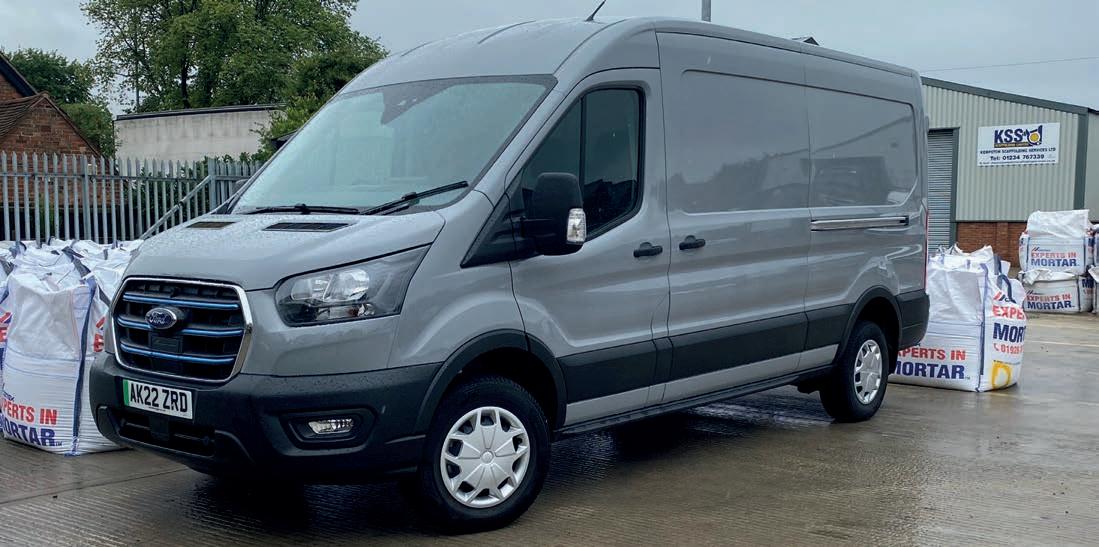
Brooks agrees that the E-Transit’s proposition is well suited to fleets: “Fleets are acutely aware of the UK legis lation of a 2030 deadline for zero emission new vehicle sales for both passenger cars and light commercial vehi cles and as such are looking to proactively plan their fleet requirements. Ford will be introducing a number of tools to help customers plan and understand the implications of EV vehicles, from a range calculator for the E-Transit that uses a number of factors to determine a specific range to a total cost-of-ownership tool that will help customers work out values versus their current diesel vehicles. Ford Pro provides customers with details on charging, connected services and the changes to the ownership experience all in one place.”
WHAT THE JUDGES SAID
TECH SUPPORT: The E-Transit runs Ford’s connectivity SYNC 4 system and is offered with access to a range of connected features
Like the list of customers already putting the E-Transit into action on their fleet, the judging panel for Motor Transport Clean Fleet Van of the Year represented a diverse cross section of the industry who all unanimously agreed on the impact the E-Transit would have on achieving their clean fleet ambitions.
One judge commented: “The vehicle seems to be a game changer, and with the backing of the Blue Oval behind it, will prove to many operators that this is the way forward.”
“The support mechanisms of Ford Pro’s E-Telematics will prove a big hit with fleet managers with regard to the insights and alerts,” said another.
MotorTransport 3510.10.22
■



























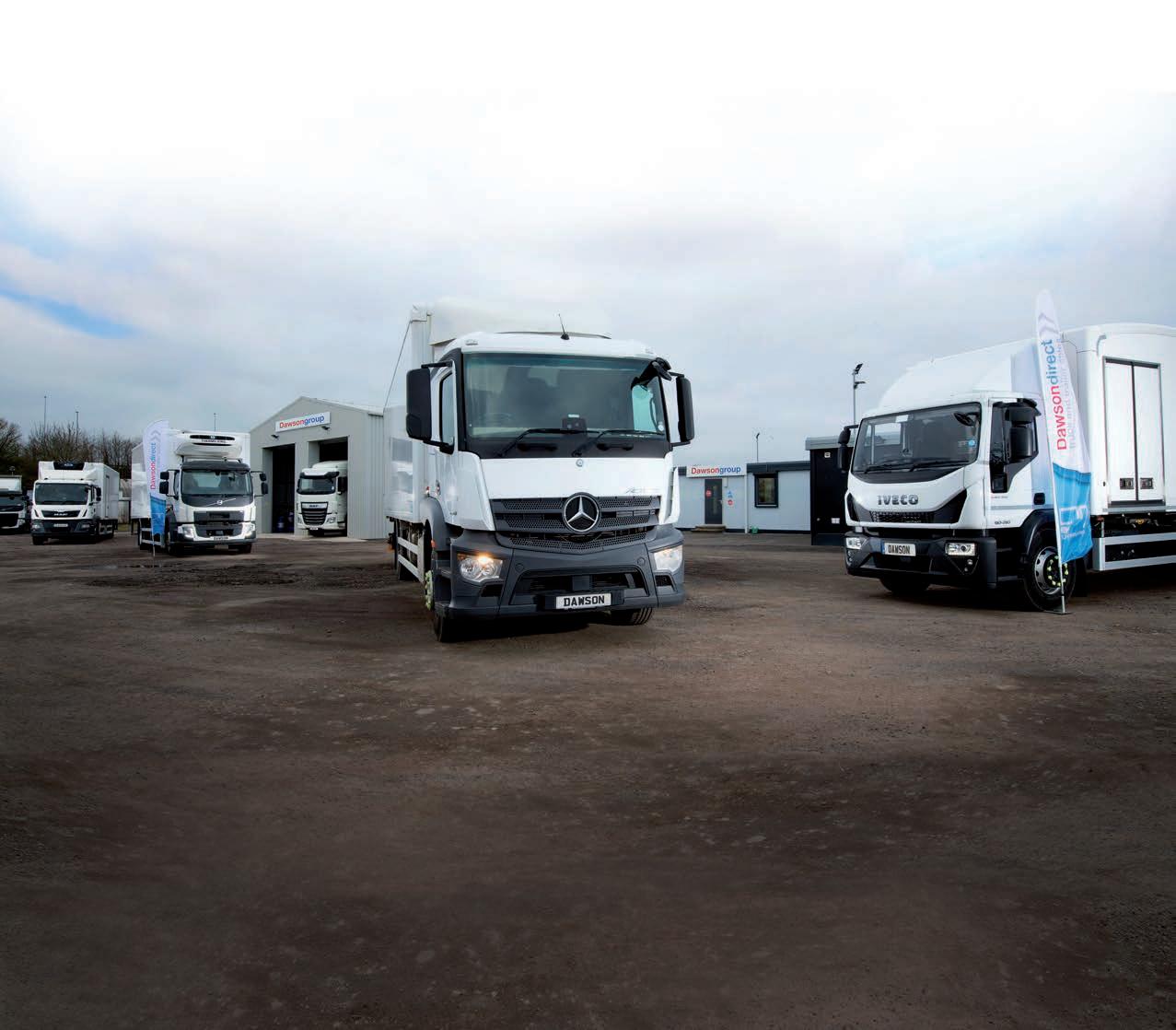
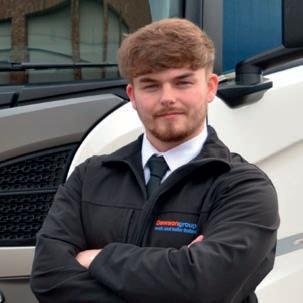

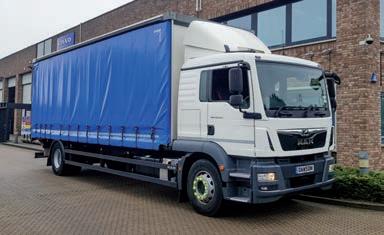















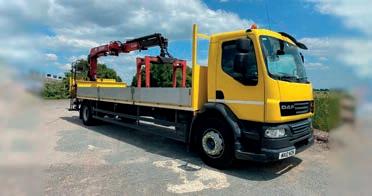






















































































































 By Chris Tindall
By Chris Tindall



















































































































